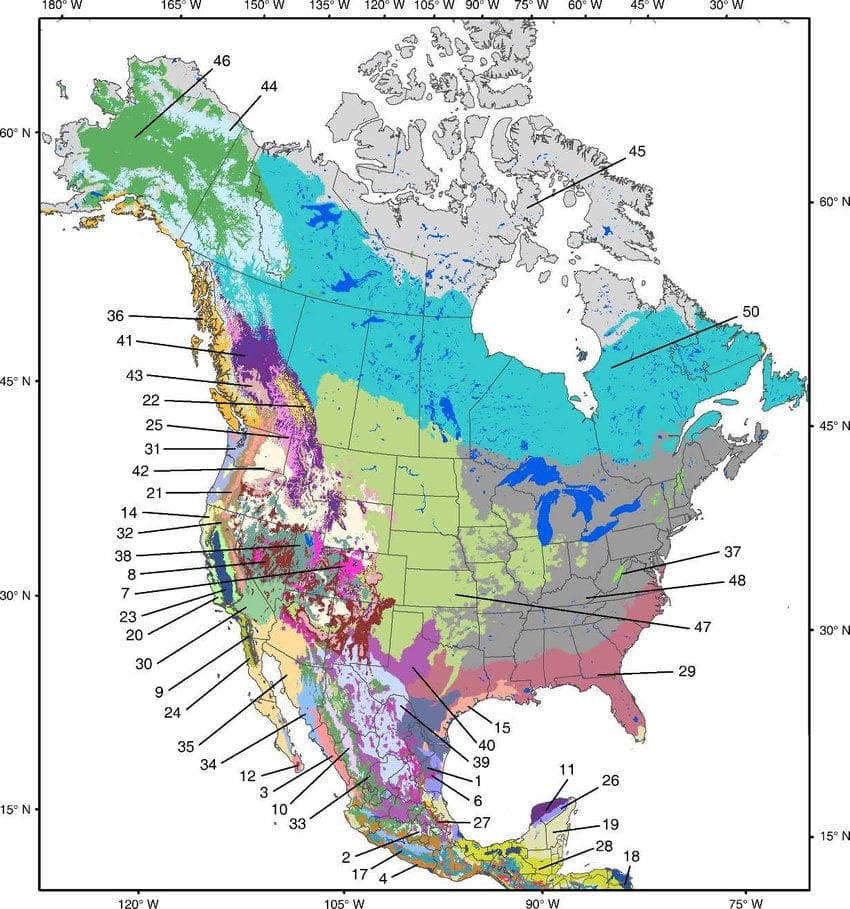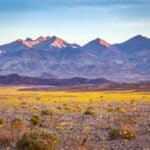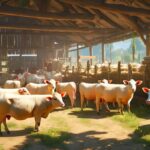Attention, nature enthusiasts! Get ready to dive into a world of diverse ecosystems in America. From the lush rainforests to the vast grasslands, we’ll take a journey through the different biomes that make up our country. Each one presents its own unique set of features, challenges, and inhabitants. Buckle up and let’s explore the tapestry of nature that makes America so amazing!
Biomes in America: A Patchwork of Life
North America is like a giant patchwork quilt, stitched together with some of the most diverse landscapes on Earth. These diverse landscapes are known as biomes – huge communities of plants and animals that have adapted to specific climates and environments. From icy tundras to steamy rainforests, the variety across America is truly awe-inspiring. Let’s take a closer look at these incredible biomes and the life they support.
Up North: Where the Wind Blows Free
Imagine a place where the ground stays frozen for most of the year, and the wind howls across a landscape dotted with hardy shrubs and lichens. This is the tundra, a biome found in the northernmost parts of North America, like Alaska and Canada. Here, life has adapted to extreme cold and short growing seasons. You’ll find caribou with their thick coats, arctic foxes blending into the snow, and resilient plants that hug the ground for warmth.
Moving south, we encounter the coniferous forests, also known as the taiga. Think towering evergreen trees like pines, firs, and spruces, their needle-like leaves designed to withstand heavy snowfall. These forests are home to iconic animals like moose, grizzly bears, and wolves, along with a chorus of birds that call this biome home.
The Heart of the Continent: Where the Buffalo Roam
As we venture further south, the trees begin to thin, giving way to vast grasslands known as the prairie. Imagine endless fields of waving grasses, home to herds of bison (or buffalo) that once roamed these lands in massive numbers. This biome is all about resilience, with plants that can survive scorching summers and frigid winters. The prairie is also home to burrowing animals like prairie dogs and a dazzling array of wildflowers that bloom in a burst of color.
Eastern Elegance: A Symphony of Seasons
The eastern part of North America boasts the deciduous forests, where trees like oaks, maples, and hickories put on a spectacular show of color each autumn before shedding their leaves. These forests are teeming with life, from deer and black bears to a multitude of songbirds and insects. The changing seasons bring a constant cycle of growth and decay, creating a rich tapestry of life.
Desert Dreams: Life Finds a Way
Don’t let the name fool you, the desert biome is far from a barren wasteland. While it’s true that deserts receive very little rainfall, the plants and animals here have developed incredible adaptations to survive. Think cacti storing water in their fleshy stems, nocturnal animals avoiding the scorching sun, and a surprising diversity of reptiles and insects that thrive in this challenging environment. From the Sonoran Desert with its iconic saguaro cacti to the Mojave Desert’s Joshua trees, these arid landscapes hold a unique beauty.
Tropical Treasures: A Riot of Life
Finally, we arrive at the tropical rainforests, found in places like Hawaii and southern Florida. Here, warmth and humidity reign supreme, creating a paradise for life to flourish. Imagine towering trees draped in vines, colorful orchids blooming on the forest floor, and a cacophony of bird calls filling the air. This biome is home to the greatest diversity of plant and animal life on Earth, with many species still waiting to be discovered.
A Delicate Balance: Our Role in Protecting Biomes
It’s important to remember that these biomes are not isolated islands. They are interconnected, with changes in one area potentially impacting others. Climate change, habitat loss, and pollution are just some of the challenges facing these precious ecosystems. By learning more about biomes and the factors that threaten them, we can all play a role in protecting these incredible natural treasures for generations to come.
What Biomes are in the United States?
The United States isn’t just about cities and towns; it boasts an amazing variety of natural landscapes, called biomes. These biomes are like different worlds within one country, each with its own unique personality. We’re talking towering mountains, wide-open grasslands, scorching deserts, and forests that burst into color come fall. It’s this incredible diversity that makes the U.S. a real hot spot for plants and animals.
Taking a Closer Look: Beyond the Big Three
We’ve talked about the big names – deciduous forests, grasslands, and deserts – but the U.S. has even more to offer.
- Mountains: Think soaring peaks, meadows bursting with wildflowers, and those iconic snow-capped summits. Mountains create a kind of natural mosaic of habitats, each with its own microclimate and fascinating creatures specially adapted to the altitude.
- Glaciers: These massive rivers of ice, mostly hanging out in mountainous areas, are like leftovers from the last ice age. They might seem unchanging, but they play a huge role in the world’s water cycle.
- Estuaries: Imagine where a freshwater river meets the salty ocean – that’s an estuary. It’s a dynamic, ever-changing environment where life has to adapt to the mix of fresh and salt water. You’ll find some truly unique plants and animals that thrive in these conditions.
- Tundra: Picture a cold, treeless landscape where the ground stays frozen for most of the year. This is tundra, found in the high latitudes and altitudes of the U.S. It might seem harsh, but it supports a surprising array of life, like low-growing plants, mosses, and lichens.
A Note on Biome Boundaries
Here’s something interesting: biomes aren’t like countries with clearly defined borders on a map. They often blend into each other in something called a transition zone or ecotone. These transition zones are super interesting because they combine characteristics of two different biomes, which means even greater biodiversity.
Ongoing Discoveries and the Future of Biomes
Scientists are always learning more about biomes and how they work. Ongoing research is looking at how climate change might affect these delicate ecosystems, and what we can do to protect them. It’s an area where there’s still much to discover and understand.
The Bigger Picture
So, why should we care about biomes? Well, they’re not just pretty landscapes; they’re vital for the health of our planet. They provide us with clean air, clean water, and fertile soil. Understanding biomes, their challenges, and how they interconnect helps us make better decisions about conservation and how we live in harmony with nature.
What are the 7 Biomes of North America?
Alright, so we’ve talked about how diverse North America is, right? Well, a big part of that diversity comes from the amazing variety of biomes we have. These biomes are like giant, living communities shaped by the climate and home to unique plants and animals. Think of them as the planet’s way of organizing life into neighborhoods, each with its own vibe. Let’s take a closer look at these awesome biomes:
- Deciduous Forest: Imagine strolling through a forest where the leaves change color with the seasons – fiery reds, golden yellows, and warm browns. That’s the magic of the deciduous forest. These forests are bursting with life, home to animals like white-tailed deer, black bears, and a symphony of songbirds. You can find these forests along the eastern edge of North America, from Canada down to the United States.
- Coniferous Forest: Now, picture towering evergreen trees like pines and spruces, their needles blanketed in snow. This is the coniferous forest, where the air is crisp and the winters are long. Here, you might spot a moose lumbering through the trees, hear the howl of a wolf pack, or catch a glimpse of a lynx on the hunt. These forests stretch across the colder regions of Canada and Alaska.
- Grassland: Ever seen a movie with endless fields of waving grass? That’s grassland for you! These wide-open spaces cover the heartland of North America, from the Great Plains to the Midwest. Here, massive herds of bison used to roam, and you can still find pronghorns sprinting across the plains, prairie dogs popping up from their burrows, and the sky filled with soaring hawks.
- Tundra: Think way up north, where the ground stays frozen for most of the year and trees are just a distant dream. That’s the tundra, a vast, treeless expanse stretching across northern Canada and Alaska. It’s a harsh but beautiful environment, home to iconic animals like caribou, polar bears, and the majestic snowy owl.
- Desert: When you think of deserts, you probably imagine scorching sun, sand dunes, and very little life. While it’s true that deserts are dry, they’re far from lifeless! These areas, found in the southwestern United States and Mexico, are home to cacti of all shapes and sizes, speedy lizards darting between rocks, and snakes perfectly camouflaged in the sand.
- Temperate Rainforest: Prepare to be amazed by the lush, green world of the temperate rainforest. These coastal forests are drenched in rainfall, allowing towering trees like redwoods and Douglas firs to thrive. Along the Pacific Northwest coast of North America, you’ll find these forests teeming with life, from salmon swimming upstream to black bears searching for berries.
- Tropical Rainforest: Think sunshine, humidity, and a mind-boggling variety of plants and animals. Welcome to the tropical rainforest! While small compared to other biomes, these rainforests in southern Florida and Hawaii are incredibly vibrant. Colorful birds flit through the trees, monkeys swing through the canopy, and exotic flowers add splashes of color everywhere you look.
Protecting Our Planet’s Neighborhoods
It’s important to remember that these incredible biomes are facing challenges. Human activities like deforestation, pollution, and climate change are putting a strain on these delicate ecosystems. That’s why it’s more important than ever to learn about and protect these natural wonders, ensuring that future generations can experience the amazing diversity of life on Earth.
What are the 7 Major Biomes?
Across the globe, we see an incredible variety of landscapes, each home to unique plants and animals. These are the Earth’s major biomes, and understanding them helps us protect our planet’s amazing natural heritage.
Let’s take a closer look at each one:
- Boreal Forest (Taiga): Imagine a vast forest stretching as far as the eye can see, filled with towering pines and spruces. It’s cold, especially in winter when the trees are covered in snow and ice. This is the Boreal Forest, found in the northern parts of the globe.
- Temperate Deciduous Forest: Think of the vibrant colors of fall – the reds, oranges, and yellows of leaves as they change before falling to the ground. This is typical of the Temperate Deciduous Forest, which experiences four distinct seasons.
- Grassland: Picture endless plains of waving grasses, with just a few wildflowers here and there. This is the Grassland Biome, home to animals like bison that graze on the abundant grasses. You can find grasslands across many continents.
- Desert: The Desert Biome is a place of extremes – scorching hot sun during the day and very little rain. Cacti, lizards, and snakes have all adapted to survive in this harsh environment.
- Tundra: Way up north, beyond the Arctic Circle, lies the Tundra. It’s a cold and treeless place where the ground stays frozen all year round (that’s called permafrost!). Only the toughest plants and animals, like caribou, polar bears, and snowy owls, can make it here.
- Coastal Biomes: Where the land meets the sea, you’ll find a variety of Coastal Biomes. These areas are influenced by the salt water and include habitats like salt marshes and mangrove forests, which are essential for many marine and land-dwelling creatures.
- Mountain Biomes: Mountains are like islands of different habitats stacked on top of each other. As you climb a mountain, you’ll notice the types of plants and animals changing. At the bottom, you might see forests, which give way to meadows higher up. Eventually, you reach the bare, rocky peaks where only the toughest species can survive.
What Shapes a Biome?
Many things influence where we find different biomes, but some of the most important factors are:
- Latitude: How far north or south a location is from the equator affects how much sunlight it receives.
- Altitude: As you go higher up, the temperature gets colder.
- Precipitation: The amount of rain or snow an area gets is crucial for plant life.
- Temperature: Different plants and animals thrive in different temperature ranges.
Protecting these biomes is vital for ensuring the diversity of life on Earth. Scientists are always learning more about how biomes work and how they are being affected by climate change and other human activities.
Why Does America Have So Many Biomes?
So, we’ve talked about how awesome and diverse America’s landscapes are, but why all the variety? Imagine a giant mixing bowl of geography and climate – that’s what’s happening here. America’s enormous size means it stretches across a wide range of latitudes, from way up north where it’s chilly to down south where it’s warm and toasty. This creates a bunch of different temperature zones, kind of like having a whole bunch of mini-climates within one big country.
Now, picture this: giant mountains rise up, acting like walls that affect where the rain falls. The Rocky Mountains, for example, create what’s called a rain shadow, making the western side drier and the eastern side lusher. It’s like two completely different worlds right next to each other! And let’s not forget those cool ocean currents, swirling around and influencing temperatures along the coasts. Think of them as giant underwater rivers that either warm things up or cool things down.
But it’s not just about today’s geography. Imagine glaciers, massive rivers of ice, carving out valleys and lakes thousands of years ago. Those glaciers left their mark, creating unique landscapes that still influence where plants and animals can thrive. And then there’s tectonic activity – think earthquakes and volcanoes – constantly reshaping the land and creating diverse habitats.
It’s like a giant puzzle, with all these factors fitting together to create the incredible range of biomes we see across America. It’s pretty amazing, right?
Of course, we can’t forget about ourselves – humans have definitely played a role too. We’ve transformed forests into farmlands and built cities where wilderness once stood. These changes have a big impact on the plants and animals that call these areas home, sometimes leading to changes in biomes over time.
It’s important to remember that our understanding of biomes is always evolving. Scientists are constantly making new discoveries about how these complex systems work, especially with the added challenge of climate change. It’s a fascinating field of study, and the more we learn, the better equipped we’ll be to protect the incredible biodiversity that makes America so special.
Are you curious about the various natural communities that exist in North America? Embark on a journey into the fascinating world of North America biomes and discover the unique ecosystems that shape this diverse continent.
- China II Review: Delicious Food & Speedy Service - April 17, 2025
- Understand Virginia’s Flag: History & Debate - April 17, 2025
- Explore Long Island’s Map: Unique Regions & Insights - April 17, 2025

















1 thought on “Exploring the Diverse Tapestry of Biomes in America”
Comments are closed.